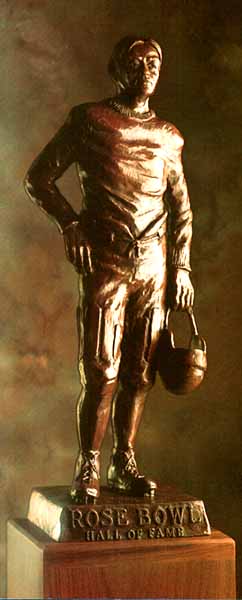
Hall of Fame
By Judy O'Sullivan
The players on every team in the PAC-10 and Big Ten want to wear Rose Bowl champion rings. So they play their hearts out to win that New Year's game in Pasadena, California. The result: scores of gridiron heroes.
After all, the Rose Bowl Game is a celebrated post-season college football contest. This eight-decade plus event is not called "The Granddaddy of Them All" for naught. Every bowl game in the country can be traced back to Pasadena.
In 1989, the Tournament of Roses Association decided the time had come to honor past glories by inaugurating a Rose Bowl Hall of Fame. Ever since, annually, those players, coaches and association members who have contributed to this All-American sport in general and specifically to the big game in Pasadena have been rewarded. These are lifetime achievement awards and not necessarily given for recent performances in Rose Bowl action.
Candidates are judged on ability as well as that intangible quality of sportsmanship. Sportswriter Grantland Rice advised long ago, "It doesn't matter if you win or lose, it's how you play the game." These men played well on and off the field.
How did this game of games end up in Pasadena anyway? Easy, it turns out. Well, the 1902 Tournament of Roses contest was a disaster. Michigan pulverized Stanford 49 to zip. The Tournament of Roses Association sacked the idea of football for fourteen years. When the country turned pigskin crazy in 1916, locals decided they had better grab some of the action.
Invitations went out for an East/West Playoff. But it poured on New Year's Day. The gridiron contest between Washington State and Brown drew crowds of only 8,000 (at Tournament Park on property now owned by Caltech.) Washington State won 14 to 0, but the association lost money--$11,000.
Thankfully, the sun shone the following year. Attendance jumped to over 25,000--more than the bleachers could handle. Success at last and a nice profit. To accommodate increasing fan-interest, the city fathers asked architect Myron Hunt to design a stadium. The Rose Bowl was completed in 1922--using Greek designs similar to those which inspired the Yale Bowl.
For the past 51 years the New Year's game in Pasadena's Rose Bowl has served as more than the play-off between the PAC-10 and the Big Ten. It's been the proverbial gold ring held out to many college athletes. A lot of heroes.
Seven years ago, the first four men accepted into the Rose Bowl Hall of Fame for helping transform this particular gridiron classic into an international event were: C.W. "Bump Elliott, University of Michigan; W.W. "Woody" Hayes, Ohio State; Howard Jones, USC; Jim Plunkett, Stanford.
Five names were added in 1990. Archie Griffin, Ohio State; Bob Reynolds, Stanford; Neil Snow, University of Michigan; Wallace Wade, Brown, University of Alabama and Duke; Charles White, USC.
In 1991, honored were Rex Kern, Ohio State; John McKay, USC; Ernie Nevers, Stanford.
By August 6, 1992, nine more college football superstars won a position in the Rose Bowl's Hall of Fame. Presented by Wells Fargo Bank, the event was held at the Rose Bowl in the Rose Bowl Court of Champions in Pasadena, California. Local sportscaster Stu Nahan acted as master of ceremonies. Accepting awards were football legacies or representatives: Frankie Albert, Stanford; Bob Chappuis, Michigan; Sam Cunningham, USC; Bob Griese, Purdue; Jim Owens, coach of Washington.
Posthumously honored were Bill Daddio of the University of Pittsburgh; Hollis Huntington of Oregon and the Mare Island Marines; Shy Huntington of Oregon, and Elmer Layden of the legendary Four Horsemen of Notre Dame who played in the 1925 Rose Bowl Game.
The Hall of Fame's list continued to grow. 1993 saw the addition of Frank Aschenbrenner, Northwestern; Don Hutson, Alabama; Curly Morrison, Ohio State; Brick Mueller, California at Berkeley; Julius Rykovich, Illinois; Bo Schembechler, Michigan; O.J. Simpson, USC; Bob Stiles, UCLA.
1994: Vic Bottari, California at Berkeley; Jim Hardy, USC; Don James, Washington; Bob Jeter, Iowa; Lay Leishman, Tournament of Roses Association--Leishman suggested building the famed stadium to resemble "the Yale Bowl in his home town, New Haven, Conn.;" Pat Richter, Wisconsin; Russell Saunders, USC.
1995: Gary Beban, UCLA; Dick Butkus, Illinois; Harry Gilmer, Alabama; Pat Haden, USC; Al Krueger, USC; Doyle Nave, USC; Ted Shipkey, Stanford.
1996: Eric Ball, UCLA; Pete Beathard, USC; John Ferraro, USC; Stan Hahn, Tournament of Roses Association; John Ralston, Stanford; Bill Trate, Illinois.
The next Hall of Fame event is planned for May of 1997. Look for new names being added to the growing ranks of Pasadena's preferred..